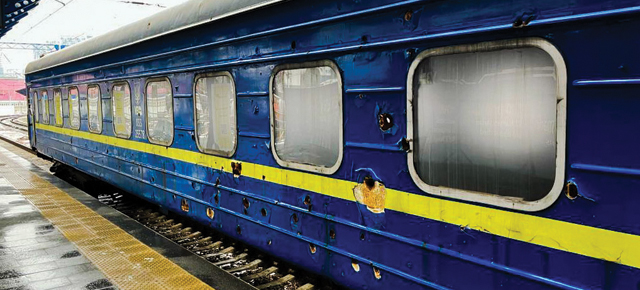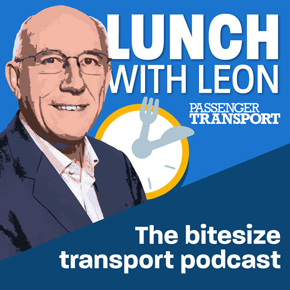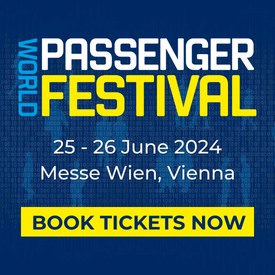On a recent visit to Ukraine I was inspired to meet so many brave, committed and talented people, who believe in the power of rail

BY David Brown
I recently had the honour of visiting Ukraine as part of an international delegation working with the Global Ukraine Rail Taskforce in partnership with the taskforce, the UK rail industry has so far raised over £106,000, providing more than 7,000 food parcels to help support Ukrainian railway workers and their families.
Over the course of our time in Ukraine, I never once heard people talk about ‘if’ they would win the war, only ‘when’. This sense of resolve and togetherness has come to define the Ukrainian resistance. It’s a large reason why the country is still standing, continuing to defy the odds nearly two years since Russia launched an invasion that was meant to be over in a matter of days.
The Ukrainian railway, or Ukrzaliznytsia, has fast become a symbol of this resilience. From the moment the war broke out, the Ukrzaliznytsia has played a vital and varied role in the conflict.
In the immediate aftermath of the invasion, the railway was a lifeline for people fleeing the Russian advance. To put the scale of the challenge into perspective, the United Nations estimates that as many as eight million people were initially displaced by the conflict, representing the largest refugee crisis in Europe since World War Two. The Ukrzaliznytsia was responsible for transporting more than half these people away from the fighting, and towards the relative safety of Western Ukraine and its neighbours.
Early on in the trip, it was sobering to be shown a wagon riddled with bullet holes. We were told that this had been carrying civilians, many of them children, at the time it was attacked. Miraculously, nobody was killed.
It was sobering to be shown a wagon riddled with bullet holes
And as the war has evolved, so too have the demands on Ukraine’s railway. As you’d expect, there is a heavy reliance on rail for moving troops, supplies and military aid. But, remarkably, the Ukrzaliznytsia is still delivering on its peacetime objectives – driving growth, supporting the economy and connecting friends and families.
It was an enormous privilege to speak directly with some of the frontline staff, managers and trade union representatives, and to learn more about how they have kept their railway running in the face of unimaginable challenges.
Oleksandr Pertsovskyi, Ukrzaliznytsia board member for passenger services, explained how, especially in the early months of the war, Russia would target rail infrastructure, attempting to disrupt supply lines and cut off troops serving on the front. Rail workers would have to be dispatched quickly, often in the middle of the night, to repair bomb-damaged rails and equipment.
In peacetime, these jobs might take days, even weeks, to complete, but the war effort can’t afford to wait that long. In response, rail engineers have been forced to innovate, coming up with new ways of working to get the line back up and running within hours, all the while, having to stay alert for the ever-present threat of further attacks.
That’s what makes it all the more remarkable; against the backdrop of a war that has turned the lives of the Ukrainian people upside down, there is still such a commitment to delivering ‘business as usual’.
In a room in Kyiv station, Oleksandr told us how passenger numbers have already recovered to pre-war levels and are even expected to hit a record high in 2024. All of this has been achieved through an unwavering focus on operational performance, and a determination to provide a service the country can rely on.
And it’s a similar story for freight, where the railway carried an all time high of 141 tonnes of food and goods in November 2023, responding to the opening of the Black Sea corridor and the ending of the Russian blockade.
But on top of these incredible achievements, it was the determination to continue improving and modernising the railway that I found most striking. The Ukrzaliznytsia has a clear long-term vision and steadfastly refuses to allow the Russian invasion to distract from it.
As we were being shown around the busy Kyiv railway station, Oleksandr told us how successful the recent roll out of a digital ticketing system has been with passengers, making it more straightforward to purchase tickets online. He drew our attention to a popular, newly-built play space in the central lobby, commenting that the area would previously have been crowded with people queueing for the limited number of ticket booths.
Nowhere is the Ukrzaliznytsia’s commitment to growth better demonstrated than through its plans to expand its network. We heard how they’re aiming to build on their domestic routes and introducing new fleet. But more than that, they’re even mapping out what they want to achieve when the war is won, with plans for new direct international services to Vienna and Warsaw.
And there is a real awareness amongst the railway’s leadership that they must do more to make their railway accessible. Accessibility should always be a priority, but the influx of veterans returning home with terrible, debilitating injuries means there is an urgent need for action. In the brief time I spent travelling on the Ukrainian railway, I saw first-hand how much work will be required, with many stations lacking step-free access, and significant drops-offs between train and platform.
As part of the wider railway family, we should all share a sense of admiration and pride for what our colleagues in Ukraine are achieving
Progress is already being made through the Ukrzaliznytsia Barrier-Free Railway program. We heard from Yevhen Lyashchenko, CEO of Ukrzaliznytsia, how they are moving at pace to make physical station alterations and introduce staff training programmes, as first steps in making the network easier for people with disabilities to navigate.
Yevhen also told us about their Back to Work initiative, which has set up a dedicated veterans’ centre to help reintegrate men and women returning from the frontline – ensuring they have access to appropriate and rewarding careers on the railway. One of the centre’s flagship schemes has seen the creation of a brand new team, which is staffed by wounded veterans and tasked with using drones to monitor and protect railroad infrastructure.
I only had the honour to be in Ukraine for a short visit, but it’s an experience that will stay with me for a lifetime. It was truly inspiring to meet so many committed and talented people, who believe wholeheartedly in the power of rail to help their country through one of its darkest periods. It’s no wonder that the Ukrzaliznytsia’s workers have earned themselves the title ‘the iron people’.
As part of the wider railway family, we should all share a sense of admiration and pride for what our colleagues in Ukraine are achieving. We have a shared responsibility to support them, particularly as the conflict progresses and their needs evolve. Moving forward, we must continue to help them, whether that’s through further financial aid and food parcels, or through sharing our experiences and expertise as the country strives to rebuild.
ABOUT THE AUTHOR: David Brown joined Arriva in September 2017 as Managing Director of Arriva Rail North and then as Arriva’s Group Communications Director before being appointed Managing Director UK Trains in October 2020. Prior to joining Arriva, he was Chief Executive of Transport for the North.
This article appears in the latest issue of Passenger Transport.
DON’T MISS OUT – GET YOUR COPY! – click here to subscribe!








